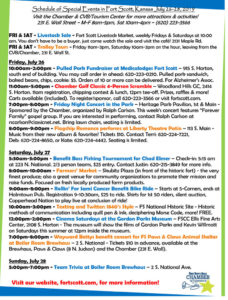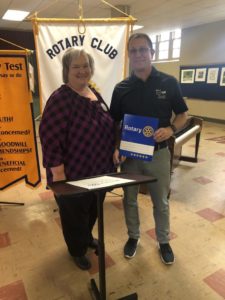
Click here if unable to view the above:2019-7-26 Weekend Flyer

Click here if unable to view the above:2019-7-26 Weekend Flyer

Iraq in the Bible
A special presentation of “Iraq in the Bible” will be held at Fort Scott’s First Southern Baptist Church on Wednesday, July 31st beginning at 6:30 pm.
The church is located at 1818 South Main in Fort Scott.
This interactive video presentation will look at the history, archeology, and prophecies of Iraq. Israel is the most mentioned nation in the Bible. Iraq is the second most mentioned nation in the Bible.
However, it is not called Iraq. Instead, Iraq is known as Nineveh, Babylon, Shinar, Assyria, Ur of the Chaldees, and Mesopotamia.
Chaplain James Collins, a retired U.S. Army Chaplain, visited all of the historic locations. Chaplain Collins will be your guide through the land of Iraq.
You are invited to attend this special free presentation. Bible Study small groups are welcome.
For more information, call Fort Scott’s First Southern Baptist Church at (620) 223-2986.

Our neighborhood here in Florida is filled with warning signs. The alligator notice posted above is one block from where Dave and I live.
The “cart” sign hangs on a wall outside our local supermarket, and a neighbor’s front door holds the “I’m happy…don’t ruin it” sign. None of us are unfamiliar with notices of caution, but how about this one? “Removing consumer labels from pillows is punishable by fines.” When I was young, I feared the pillow police would show up at my door if I tore off one of those scratchy tags. (Tell the truth; you did too.)
Humorous signs now are the norm. “Children left unattended will be given a Red Bull and a puppy.” “Do not cross this pasture unless you can do it in nine seconds because the bull can do it in ten.” “Stay off the tracks. They are only for trains. If you can read this, you’re not a train.”
Most warnings, however, are not laughable. We heed them…or we pay the consequences. Especially ones God has given us. Every book in the Bible cautions us about what our bad choices can do to us…and to others. Our problem is that sometimes we don’t take the warnings seriously, if we read them at all.
For example, God gave strict instructions on how to choose the right spouse. I have Christian friends who chose their mates only after much prayer, seeking God’s wisdom because of the decision’s lifetime importance. (I wasn’t one of those people, I admit, but God blessed me in spite of myself.) With the divorce rate in the U.S. nearing 40% (one site said that every 13 seconds, there is a divorce in America), many couples—Christians included– are choosing to split.
In Judges’ chapters 13-16, we read of a tragic story in which a young man disobeyed God’s marriage order, and it cost him his life. You’ve probably heard his name, synonymous with what NOT to do in choosing the right mate. Samson. For starters, he refused to listen to his parents’ warning. I have known three sets of praying parents who convinced their children that they were marrying the wrong person. All now are happily married in a union blessed by their father and mother and are grateful for the wisdom in their parents’ concerns.
Don’t get me wrong. I am not saying all parents know what is best for their children. Many times wedges are drawn when personalities clash with future in-laws as they circumvent God’s best with their attempts to break up a relationship. Children need to recognize the difference in motive. They need to pray for God’s wisdom.
That did not enter Samson’s mind. Worse than not heeding his father and mother, he disregarded God’s advice and lusted after a beautiful Philistine woman, a no-no to any God-fearing Israelite, much less a young Nazarite (set apart from birth to honor God) like Samson. Suffice it to say, Samson ended up being captured and blinded before dying, thanks to the sinful woman he chose as his wife.
Readers, I think I have this figured out. Messing with an alligator might be much safer than messing with an ungodly spouse.
Public Health Advisories for Kansas Lakes Due to Blue-Green Algae
Seven lakes with warnings; nine with watches
TOPEKA – The Kansas Department of Health and Environment (KDHE), in conjunction with the Kansas Department of Wildlife, Parks and Tourism (KDWPT), has issued public health advisories for Kansas lakes.
Warnings:
Big Eleven Lake, Wyandotte County (unchanged)
Jerry Ivey Pond, Saline County (unchanged)
Marion County Lake, Marion County (unchanged)
*Gathering Pond near Milford (Hatchery Supply Pond), Geary County (unchanged)
South Lake, Johnson County (unchanged)
Colby City Pond (Villa High Lake), Thomas County (unchanged)
Lebo Kids’ Pond, Coffee County (new 7/25)
When a warning is issued, KDHE recommends the following precautions be taken:
Watches:
Lake Shawnee, Shawnee County (unchanged)
Marion Reservoir, Marion County (unchanged)
Keith Sebelius Reservoir, Norton County (unchanged)
Rock Garden Pond (Gage Park), Shawnee County (unchanged)
Hiawatha City Lake, Brown County (downgraded 7/25 from warning)
Lovewell Reservoir, Jewell County (downgraded from 7/25 warning)
Westlake in Gage Park, Shawnee County (new 7/25)
Lake Afton, Sedgwick County (new 7/25)
Hodgeman County State Fishing Lake, Hodgemen County (new 7/25)
A watch means that blue-green algae have been detected and a harmful algal bloom is present or likely to develop. People are encouraged to avoid areas of algae accumulation and keep pets and livestock away from the water.
During the watch status, KDHE recommends the following precautions be taken:
KDHE samples publicly-accessible bodies of water for blue-green algae when the agency receives reports of potential algae blooms in Kansas lakes. Based on sampling results, KDHE reports on potentially harmful conditions.
Kansans should be aware that blooms are unpredictable. They can develop rapidly and may float around the lake, requiring visitors to exercise their best judgment. If there is scum, a paint-like surface or the water is bright green, avoid contact and keep pets away. These are indications that a harmful bloom may be present. Pet owners should be aware that animals that swim in or drink water affected by a harmful algal bloom or eat dried algae along the shore may become seriously ill or die.
For information on blue-green algae and reporting potential harmful algal blooms, please visit www.kdheks.gov/algae-illness/index.htm.
###
High Risk of West Nile Virus Activity in Three Kansas Regions
and Positive Mosquito Pools Identified
TOPEKA – The Kansas Department of Health and Environment (KDHE) has issued a high risk warning for West Nile virus infections (WNV) for northwest, south central and southeast Kansas. North central, northeast, and southwest Kansas are at moderate risk for WNV infections. In addition, mosquitoes collected in Sedgwick County have tested positive for WNV and St. Louis Encephalitis virus (SLEV).
WNV can be spread to people through mosquito bites, but it is not spread from person to person. About 1 in 5 people who are infected develop a fever and other symptoms such as headache, body aches, joint pains, vomiting, diarrhea, or rash. About 1 out of 150 infected people develop a severe illness leading to swelling of the brain or brain tissue that can result in death. There are no vaccines or medications to treat WNV. People who have had WNV before are considered immune.
SLEV is transmitted by the same type of mosquito that spreads WNV. While most people who are infected with SLEV have no symptoms or only mild non-specific flu-like illness, some individuals can experience serious neuroinvasive illness. Symptoms often include fever, headache, stiff neck, disorientation, and altered level of consciousness. Coma, convulsions, and paralysis may also occur. SLEV has a similar incubation period as WNV, 5-15 days.
KDHE recommends knowing your risk of WNV and take action to prevent mosquito bites and protect yourself against WNV and SLEV:
Most WNV infections occur in the late summer and early fall. Although there have been no cases of WNV reported to KDHE in 2019, there have been over 300 cases of the most severe form of WNV and 30 deaths in Kansas from 1999-2018. The last known case of SLEV in Kansas occurred in 2004.
The Centers for Disease Control and Prevention provides this web page with additional information about West Nile virus and preventing mosquito bites: http://www.cdc.gov/features/StopMosquitoes/. More information on SLEV can be found at https://www.cdc.gov/sle/index.html .For questions about West Nile virus or other Arboviral diseases contact the KDHE Epidemiology hotline at 877-427-7317.
Governor Laura Kelly reappointed Carisa Lyn McMullen to the State Board of Technical Professions.
“We need qualified individuals overseeing engineering, architecture, geology, land surveying and other practices that have a far-reaching impact on our everyday lives,” Kelly said. “Carisa has been a real asset on this board with her extensive knowledge and experience.”
McMullen, Olathe, is a landscape architect and currently serves as the principal at Landworks Studio. She has worked in both municipal and private sectors. McMullen received a bachelor’s degree in landscape architecture from Kansas State University. She has worked on numerous projects including: University of Kansas West Campus Master Plan in Lawrence, the Dwight D. Eisenhower National Airport in Wichita, The Labette Community College Pedestrian Corridor in Parsons, and the Vision Iola Community Master Plan in Iola.
The board registers and licenses engineers, architects, surveyors and landscape architects. The group works to provide maximum protection of the health, safety, and welfare of Kansans by assuring their practice of engineering, architecture, land surveying, landscape architecture and geology in the state is properly carried out.
Per K.S.A 74-7005, each member of the State Board of Technical Professions must be a resident of the state of Kansas. Each term is four years with a limit of three successive terms.
All 13 board members are appointed by the governor. Four members must be licensed engineers, two must be licensed surveyors, three must be licensed architects, one must be a licensed landscape architect, one must be a licensed geologist, and two must be from the general public.
Fort Scott Area Community Foundation announces their grant cycle for 2019
The Fort Scott Area Community Foundation is pleased to announce that the grant cycle for 2019 is here. We will be taking applications from now until August 31st.
This year, we will be awarding over $33,000.00 to local not-for-profits for projects to benefit our community.
A certain dollar amount of the awards is reserved for projects that benefit our youth.
Maximum grant to any one project is $5,000.00.
Applications can be obtained by sending an email to [email protected].
Please use the same email address to submit any questions you might have. Completed applications must be received by 5:00PM, August 31st.

Robert Uhler Confirmed as New Rotarian
Rotary Club of Fort Scott welcomed new member, Robert Uhler during a weekly meeting. He will be serving as the club’s secretary for the 2019-2020 year.
Uhler moved to Fort Scott in 2000 and currently works as the Director of Community Development for the City of Fort Scott.
He and wife, Laurie have two children and two grandchildren.
The Fort Scott Rotary club meets every Wednesday at noon at the Presbyterian Church.
Anyone interested in learning more about Rotary’s mission to serve the local community can contact Lindsay Madison, Rhonda Dunn, or Shirley Palmer.
Governor Laura Kelly appointed Dylan Evans, Sarah Green, and Kathy Brazle to the Kansas State Fair board.
“The Kansas state fair is an important part of Kansas’ story,” Kelly said. “It’s a cherished annual tradition, and Kansans deserve board members who are passionate about our history and culture. Dylan, Sarah, and Kathy encapsulate this passion.”
The board acts as the showcase of Kansas agriculture, commerce and industry, and is responsible for presenting a format of entertainment and education that appeals to people from all walks of life in Kansas.
The state fair emphasizes the importance of family, education, public and private entities, and Kansas as a whole.
Dylan Evans, Lebo, is the owner of Farmers State Bank of Aliceville and DWE Livestock. Evans received his master’s degree in food science, a bachelor’s degree in animal science and industry, and a bachelor’s degree in food science and industry, all from Kansas State University. He succeeds Steve Abrams.
Sarah Green, Wichita, currently serves as a writer, editor, and strategic consultant, working as an independent contractor. Previously, she served as Local Foods and Rural Outreach Coordinator under the Kansas Department of Agriculture. Green participated in a graduate fellowship through George Washington University in food policy. She received her bachelor’s degree in journalism from the University of Kansas. She succeeds Matthew Lowen.
Kathy Brazle, Chanute, is a retired school administrator. Previously a teacher in Erie, Brazle received her bachelor’s degree in mathematics and physical education from Southwestern College and a master’s degree in physical education from the University of Kansas. Brazle also received an administration certification from Emporia State University. She succeeds Monica Lair.
The governor’s appointments to the state fair board are not subject to Senate confirmation.

An apparel department is being added to Gordmans department store that opened earlier in 2019 in Fort Scott. The store is located at 2400 S. Main, in the strip mall on the southside of town.
“Gordmans in Fort Scott will be expanding to a full-fledged Gordmans, which will offer big brands in merchandise for the entire family at very low prices compared to department store prices,” Blakeley Graham, Manager of Brand Publicity at Gordmans, said. “The complete changeover will be August 10, and Gordmans is planning a special in-store event that day to celebrate the expansion.”
“In addition to the home décor, beauty merchandise, fragrances, accessories and toys already available at Gordmans, there will be name brand apparel for all ages and footwear at bigger deals and smaller prices,” he said.
Gordmans is part of the Stage family of stores.
Stage has opened 74 Gordmans this year, including the store in Fort Scott. By the end of 2019, there will be over 150 Gordmans stores across the country.

More details will be shared soon about the August 10 event, according to Graham.